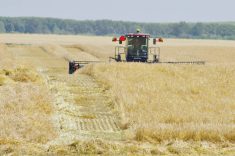Drought cont inues to plague the U.S. Plains hard red winter wheat region and there is no relief in sight from the dryness until at least October, an agricultural meteorologist said Sept. 23.
It remains quite dry and it will remain that way for at least three weeks, on into October, said Don Keeney, meteorologist for MDA EarthSat Weather.
Light and scattered showers over the past week provided only minor relief from the devastating drought that has left most wheat seedbeds starved of moisture and cooked grazing land sending young cattle into feedlots prematurely.
Read Also

Manitoba sclerotinia picture mixed for 2025
Variations in weather and crop development in this year’s Manitoba canola fields make blanket sclerotinia outlooks hard to pin down
Warmer temperatures next week also will sap soil moisture as readings jump to the 70s and 80s F with some lower 90s F in the south, Keeney said.
The U.S. Department of Agriculture (USDA) on Sept. 19 said 14 per cent of the U.S. winter wheat crop had been planted, up from six per cent a week ago but behind the 20 per cent five-year average seeding pace.
Scattered rainfall through the U.S. South brought some brief relief to drought-hit Texas and neighbouring states over the last week, but conditions remained dire, according to a climatology report issued Sept. 22.
Farmers are expected to plant wheat regardless of soil moisture levels in hopes of a break from the devastating drought and heat wave over the summer.
If it remains dry, the crop will not germinate and grow properly, threatening production prospects for the 2012 crop that will be harvested next summer.
Conversely, wet weather in the eastern Midwest is slowing early harvest of corn and soy and hampering drydown of mature crops while dryness in the western Midwest is boosting harvest.
USDA said 46 per cent of the corn crop was mature and 10 per cent had been harvested, in line with the five-year average harvest pace of 11 per cent.
Thirty-three per cent of the soybean crop was dropping leaves and ready for harvest, below the five-year average of 47 per cent, according to the USDA.
USDA said 93 per cent of the spring wheat crop had been harvested, up from 83 per cent a week ago and ahead of the five-year average of 92 per cent.


















